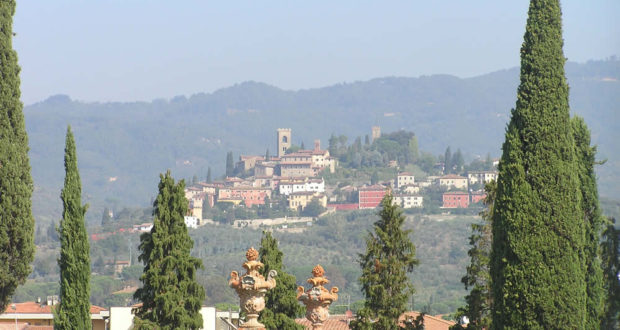Buggiano Castello, located on a small hill, is the historic nucleus of the municipality of Buggiano, where there was a castle since the Middle Ages. Further down, another village was formed over time, today Borgo a Buggiano, home to the livestock market.
The castle, strategically very important, was disputed between the republics of Florence and Lucca during the 13th and 14th centuries, but starting from 1339 Buggiano and all of the Valdinievole became Florentine possessions. The castle of Buggiano was the seat of the Municipality and Podesteria until 1775, then the administration was transferred to the Borgo.
BORGO A BUGGIANO
In the town of Borgo a Buggiano is Palazzo Carozzi-Sannini, an 18th-century building which now houses the municipal library. Also in the center of the town is the Basilica of the SS. Crucifix a church dating from the thirteenth century, but modified in the eighteenth century, the interior of the church is in the Baroque style. Among the things to see inside the church: an ancient organ, some paintings and a 14th century wooden crucifix.
The Pieve di Sant’Andrea in Stignano, a village that was the birthplace of Coluccio Salutati, is a medieval building that dates back to the 11th century and which preserves fragments of frescoes from the 14th century. A little more recent is the Pieve di San Lorenzo located in the town of Colle di Buggiano, this church with a beautiful Romanesque bell tower dates back to the 13th century, inside there are some interesting 16th century paintings.

BUGGIANO CASTLE
The medieval village of Buggiano Castello overlooks Borgo a Buggiano from the top of a hill 179 meters high. The village has maintained its ancient medieval appearance with remains of the walls such as the San Martino gate and valuable buildings. Piazza della Pieve is beautiful, overlooked by the 12th century Palazzo Pretorio with numerous ancient coats of arms on the facade.
In the same square there is also the Romanesque church of the Madonna della Salute and San Nicolao built in the 11th century as a church of the Benedictine abbey, this church has three naves inside, with a semicircular apse. The church houses numerous works of art and a small museum of sacred art. At the highest point of the town are the remains of the fortress with two medieval towers, one with merlons and the other with a 16th century clock.
The baptismal font is built with inlaid marble slabs (12th-13th century). The slabs were probably part of an ambo and of the barriers that divided the part dedicated to the monks from that for the faithful. The marble lectern also belonged to the same complex. Note an “Annunciation” of 1442, attributed to Bicci di Lorenzo; a “Baptism of Jesus” and a “Madonna del Rosario”, by Giovanni del Brina; two polychrome terracotta statues depicting “San Benedetto” and the “Madonna with Child”, from the 16th century. XVI.
In the surroundings of Buggiano there are some beautiful villas such as the baroque Villa Bellavista and near Buggiano Castello the eighteenth-century Villa Sermolli. Near Villa Bellavista there is also the Augustinian convent of Santa Maria in Selva dating back to the 13th and 14th centuries. Inside there are some frescoes from the 14th and 15th centuries, and a series of frescoes by Niccolò Nannetti from the 18th century as well as a beautiful Renaissance cloister.
 Borghi di Toscana Guida ai borghi e ai paesaggi della Toscana
Borghi di Toscana Guida ai borghi e ai paesaggi della Toscana


















